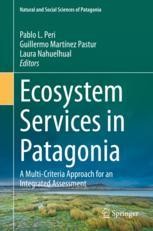Ver ítem
- xmlui.general.dspace_homeCentros Regionales y EEAsCentro Regional Patagonia SurEEA Santa CruzPartes de librosxmlui.ArtifactBrowser.ItemViewer.trail
- Inicio
- Centros Regionales y EEAs
- Centro Regional Patagonia Sur
- EEA Santa Cruz
- Partes de libros
- Ver ítem
Ecosystem services as a tool for decision making in Patagonia
Resumen
The Patagonia region that lies within two countries (12% in Chile and 88% in Argentina) has some of the most extensive wilderness areas in the planet (forests, shrublands, grasslands, and wetlands), as well as many low affected coastal-marine ecosystems. However, this “last frontier of capitalism” has started to experience the simultaneous expansion of the green and blue growth sectors, with unknown consequences for biodiversity, ecosystem services (ES)
[ver mas...]
The Patagonia region that lies within two countries (12% in Chile and 88% in Argentina) has some of the most extensive wilderness areas in the planet (forests, shrublands, grasslands, and wetlands), as well as many low affected coastal-marine ecosystems. However, this “last frontier of capitalism” has started to experience the simultaneous expansion of the green and blue growth sectors, with unknown consequences for biodiversity, ecosystem services (ES) and livelihoods. In this chapter, we (i) present a conceptual framework for the sustainable management of the natural ecosystems in Patagonia that guides the chapters of this book and (ii) highlight the importance of the ES approach for better decision-making. Our conceptual framework starts from a non-dichotomous conception of the relationships between society and ecosystems. This determines a socio-ecosystem composed by a biophysical, economic-productive and socio-political-cultural sub-system. One major challenge in Patagonia is that ES are often unrecognized and
undervalued and, therefore, ignored in market transactions, government policies and land and ocean management practices. In this context, this book aims to highlight the multiple ES provided by Patagonian ecosystems, their relation to ecosystems’ functioning, how they sustain human well-being and the threats they are subjected to.
[Cerrar]

Autor
Peri, Pablo Luis;
Nahuelhual, Laura;
Martínez Pastur, Guillermo José;
Editor - Compilador
Peri, Pablo Luis;
Martínez Pastur, Guillermo José;
Nahuelhual, Laura;
Fuente
Ecosystem Services in Patagonia: A Multi-Criteria Approach for an Integrated Assessment (Eds. Peri P.L.; Martínez Pastur G.; Nahuelhual L.). Switzerland : Springer. Chapter 1, p. 1-17.
Fecha
2021-04-27
Editorial
Springer
ISSN
2662-3463
2662-3471
2662-3471
ISBN
978-3-030-69165-3 (hardcover)
978-3-030-69168-4 (Softcover)
978-3-030-69166-0 (eBook)
978-3-030-69168-4 (Softcover)
978-3-030-69166-0 (eBook)
Formato
pdf
Tipo de documento
parte de libro
Palabras Claves
Derechos de acceso
Restringido
 Excepto donde se diga explicitamente, este item se publica bajo la siguiente descripción: Creative Commons Attribution-NonCommercial-ShareAlike 2.5 Unported (CC BY-NC-SA 2.5)
Excepto donde se diga explicitamente, este item se publica bajo la siguiente descripción: Creative Commons Attribution-NonCommercial-ShareAlike 2.5 Unported (CC BY-NC-SA 2.5)

